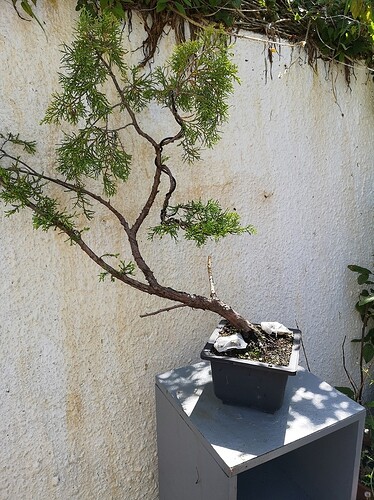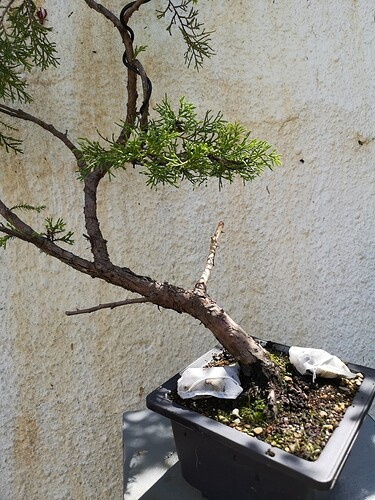Hi there,
Would like to know everyones ideas on where to take this to the next level. Was brought at a garden centre over a year ago that was hiding away in the back corner with no label on, I think it is a Juniper but might be wrong. I was potentially going to add some shari and deadwood to the left hand side and create another pad formation at the top plus the apex.
Compact and compress. Use structural wire to bring the apex down as though it was crushed by ice and snow in an alpine environment. I see some back budding on the branches that are a good sign for the ability to shorten the leggy branches. To increase back budding let it grow let it grow let it grow! The more foliage the more nutrients and water will be carried. Health and growth are the immediate requirements. The branches are very flexible. Avoid any S curves or spiral movement that cry out an artificial form. Go to the Mirai gallery and view the movement of ancient junipers. Steal a movement from an ancient tree and try to reproduce it. Always be aware of what the plant is telling you. The base of the tree and the trunk limit what is attainable. Listen to what the plant is telling you.
MOST IMPORTANT! Have fun, learn lots, share with others.
![]()
Thanks Bob really great advise, I will reduce the height and bring the top branches down later in the year. This tree defoantly needs some deadwood
For younger stock, I have to hold back for the health of the tree and let all the structures grow to get to the caliber and shape that deadwood looks natural.
What I do to achieve the live and dead feature that junipers cry out for, is use a weathered piece of deadwood as a companion when displaying the tree in development. So, I believe to cut into the trunk or branches would be a mistake right now. Structural wiring that gives the trunk and branches a twisting motion will eventually give the duality of deadwood existing side by side with the live vein. Unfortunately, or fortunately, depending on your point of view, I have killed a lot of junipers and have a selection of deadwood available to use as a companion, or focal point when displaying the younger trees. You can find deadwood pre shaped at aquarium stores or walk by a reservoir or lake and find them washed up after the spring flooding is past. The walk along the shore line is a time for contemplation of nature and how the wood appears after decades of weathering from rock and sand and water.
![]()
Another fantastic idea, thank you. Much appreciated


